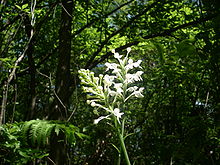- Platanthera blephariglottis
-
White Fringed Orchid 
Flower of Platanthera blephariglottis Scientific classification Kingdom: Plantae (unranked): Angiosperms (unranked): Monocots Order: Asparagales Family: Orchidaceae Subfamily: Orchidoideae Tribe: Orchideae Subtribe: Orchidinae Genus: Platanthera Species: P. blephariglottis Binomial name Platanthera blephariglottis
(Willd.) Lindl.Varieties - P. blephariglottis var. blephariglottis (Willd.) Lindl.
- P. blephariglottis var. conspicua (Nash) Luer
Synonyms - Orchis blephariglottis Willd. (basionym)
- Orchis ciliaris var. alba Michx.
- Habenaria blephariglottis Hook.
- Platanthera holopetala Lindl.
- Platanthera blephariglottis var. holopetala (Lindl.) Torr.
- Platanthera ciliaris var. blephariglottis (Willd.) Chapm.
- Habenaria blephariglottis var. holopetala (Lindl.) A.Gray
- Habenaria ciliaris var. holopetala (Lindl.) Morong
- Blephariglottis blephariglottis (Hook.) Rydb.
- Blephariglottis blephariglottis var. holopetala (Lindl.) Rydb.
- Blephariglottis alba House
- Habenaria blephariglottis f. holopetala (Lindl.) J.Rousseau & B.Boivin
- Platanthera blephariglottis f. holopetala (Lindl.) P.M.Br.
Platanthera blephariglottis, commonly known as the White-fringed Orchid or White-fringed Orchis, is a species of orchid of the genus Platanthera. It is considered to be an endangered species in Connecticut and Ohio, a threatened species in Florida, Maryland and Rhode Island, exploitably vulnerable in New York,[6] and susceptible to be threatened in Québec.
Platanthera is a Greek word that means "flat" and "flower" for this use it means "wide or flat anthered", blephariglottis from blepharis which means "eyelash" or "fringed" and glottis for "mouth-like".[7]
Contents
Description
Flowering from late spring until summer, Platanthera blephariglottis is an 8 to 110 centimeters (3 to 43 inches) tall plant that can be found growing in bogs and on the moist banks of lakes and rivers on the eastern side of North America.
- Stem and leaves
- At least 2 and often several spreading to ascending leaves scattered along the stem. Leaf shapes from linear-lanceolate, ovate-lanceolate and elliptic-lanceolate.[4]
- Flowers
- Dense to lax spikes of showy white flowers. Lateral sepals bent downward and outward more than 90 degrees. Petals are near entire fringed and the shape is linear and narrows toward the point of attachment.[4]
Distribution
Often found growing in sphagnum and other acidic moss, in open wet areas in Black Spruce and/or Tamarack bogs or on the boggy shores of lakes and in open wet meadows.[8][9][10]
- Native
-
- Nearctic
- Eastern Canada: Ontario, Quebec
- Northeastern United States: Connecticut, Maine, Michigan, New Hampshire, New Jersey, New York, Ohio, Pennsylvania, Rhode Island, Vermont
- North-Central United States: Illinois, Missouri, Wisconsin
- Southeastern United States: Alabama, Delaware, Florida, Georgia, Louisiana, Maryland, North Carolina, South Carolina, Virginia
- South-Central United States: Texas
See also
References
- ^ Lindley, John (1835). The Genera and Species of Orchidaceous Plants. Ridgways, Piccadilly. http://www.botanicus.org/page/393248. Retrieved 2008-06-03.
- ^ International Organization for Plant Information (IOPI). "Plant Name Search Results" (HTML). International Plant Names Index. http://www.ipni.org/ipni/idPlantNameSearch.do?id=30050119-2. Retrieved 2008-06-03.
- ^ "Platanthera blephariglottis (Willd.) Lindl.". Integrated Taxonomic Information System. http://www.itis.gov/servlet/SingleRpt/SingleRpt?search_topic=TSN&search_value=43419. Retrieved 3 June 2008.
- ^ a b c "25. Platanthera blephariglottis (Willdenow) Lindley". Flora of North America (efloras) 26: Page 552, 564, 567, 568, 569, 571.
- ^ "Habenaria blephariglottis (Willd.) Hook.". Tropicos. Missouri Botanical Garden. http://www.tropicos.org/Name/23512079. Retrieved 2008-06-03.
- ^ a b "Platanthera blephariglottis". Natural Resources Conservation Service PLANTS Database. USDA. http://plants.usda.gov/java/profile?symbol=PLBL. Retrieved 2008-06-03.
- ^ Robert W. Freckmann Herbarium. "Platanthera blephariglottis". University of Wisconsin, Stevens Point. http://wisplants.uwsp.edu/scripts/detail.asp?SpCode=PLABLE. Retrieved 2008-06-03.
- ^ Intermountain Herbarium Server (USU-UTC) (26 Apr 2007). "Fact Sheet Platanthera blephariglottis (Willd.) Lindl.". Intermountain Herbarium Server (USU-UTC). Utah State University. http://utc.usu.edu/factsheets/platfsf/Platanthera_blephariglottis.htm. Retrieved 2008-06-03.
- ^ Goltz, James P. (1996). "Platanthera blephariglottis (Willd.) Lindley". Muskoka Flora. University of Toronto Library. http://www.library.utoronto.ca/muskoka_flora/species/sp0022.htm. Retrieved 2008-06-03.
- ^ "Eastern prairie fringed-orchid ( Platanthera blephariglottis )" (PDF). Morris Arboretum of the University of Pennsylvania. 4 September 2007. http://www.naturalheritage.state.pa.us/factsheets/15445.pdf. Retrieved 2008-06-03.
- ^ Wisconsin State Herbarium. "Taxon - Platanthera blephariglottis (Willd.) Lindl.". Wisflora - Vascular Plants. University of Wisconsin, Madison. http://www.botany.wisc.edu/wisflora/scripts/detail.asp?SpCode=PLABLE. Retrieved 2008-06-03.[dead link]
External links
 Media related to Platanthera blephariglottis at Wikimedia Commons
Media related to Platanthera blephariglottis at Wikimedia Commons This article incorporates text from the public domain 1913 Webster's Dictionary.
This article incorporates text from the public domain 1913 Webster's Dictionary.- "White Fringed Orchid". Connecticut Wildflowers. Connecticut Botanical Society. 13 November 2005. http://www.ct-botanical-society.org/galleries/platantherablep.html. Retrieved 2008-06-03.
- Langdon, K. R.. "A NATIVE TERRESTRIAL ORCHID, PLATANTHERA BLEPHARIGLOTTIS THE WHITE FRINGED ORCHID". Botany Circular. Florida Department of Agriculture and Consumer Services. http://www.doacs.state.fl.us/pi/enpp/botany/botcirc/Botcirc23.htm. Retrieved 2008-06-03.
- "Platanthera blephariglottis (Willd.) Lindl. var. blephariglottis". Digital Atlas of the Virginia Flora. Virginia Botanical Associates. http://www.biol.vt.edu/digital_atlas/index.php?do=plant&plant=118. Retrieved 2008-06-03.
Further reading
- Niering,W., Olmstead, N., National Audubon Society Guide to North American Wildflowers, Eastern Region,1995, plate 151 and page 655, ISBN 0-394-50432-
Categories:- Orchid species
- Flora of the Eastern United States
- Platanthera
- Orchidoideae stubs
Wikimedia Foundation. 2010.

